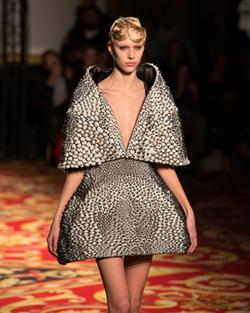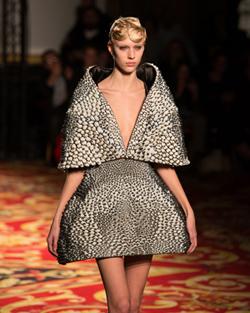3D-Printed Clothing Hits the Paris Runway
January 25, 2013

Stratasys Ltd. and Materialise have printed 3D clothing pieces that were worn on the catwalk of Paris Fashion week in the Iris van Herpen's haute couture show, "Voltage."
Two pieces out of the 11-piece collection were 3D printed. One creation, a cape and elaborate skirt, was 3D printed by Stratasys and created with Neri Oxman, an artist, architect, designer, and professor from MIT's Media Lab. Stratasys's Objet Connex multi-material 3D printing technology was used. This technology can use a variety of material properties to be printed into a single build, which allowed both soft and hard materials to be used to give the piece movement and texture.

"The ability to vary softness and elasticity inspired us to design a 'second skin' for the body acting as armor-in-motion; in this way we were able to design not only the garment's form but also its motion," said Oxman, in a press release. "The incredible possibilities afforded by these new technologies allowed us to reinterpret the tradition of couture as 'tech-couture' where delicate handmade embroidery and needlework is replaced by code."
The other creation, an intricate dress, was 3D printed by Materialise and created with Julia Koerner, an Austrian architect and lecturer at UCLA Los Angeles. The piece has intricate lace-like texture that was created with precision through laser sintering and is described as being a flexible, soft dress.
Julia Koerner, in the press release, said:
My collaboration with Materialise for the 3D-printed dress reveals a highly complex, parametrically generated, geometrical structure. The architectural structure aims to superimpose multiple layers of thin woven lines, which animate the body in an organic way. Exploiting computational boundaries in combination with emergent technology selective laser sintering, of a new flexible material, lead to enticing and enigmatic effects within fashion design. New possibilities arise such as eliminating seams and cuts where they are usually placed in couture.
Designer Iris van Herpen wanted to collaborate with Oxman after seeing her "Imaginary Beings: Mythologies of the Not Yet" collection that was featured in Paris last spring. The collection was 3D printed by Stratasys's matchless Objet Connex multi-material 3D printing technology.
Oxman said:
This project has taken 'Imaginary Beings' to 'Wearable Beings,' myths that one can wear. The original collection includes 18 Stratasys 3D-printed prototypes for the human body inspired by Jorge Luis Borges' The Book of Imaginary Beings. They are human augmentations inspired by nature; but not all wearable. For Iris' collection at Paris Fashion Week it was important to take the series to the next level, thinking not only about form and materials, but also about movement and wearability. It inspired us to design algorithms that could map physical movement and material behavior to geometrical form and morphological variation in a seamless and continuous wearable surface.
Designer Iris van Herpen, in the press release, added:
I find the process of 3D printing fascinating because I believe it will only be a matter of time before we see the clothing we wear today produced with this technology, and it's because it's such a different way of manufacturing, adding layer-by-layer. It will be a great source of inspiration for new ideas.
Oxman's 3D printed skirt and cape will be exhibited at Massachusetts Institute of Technology's media lab following the Paris Fashion Show.
Related posts:
About the Author(s)
You May Also Like
.jpg?width=300&auto=webp&quality=80&disable=upscale)


